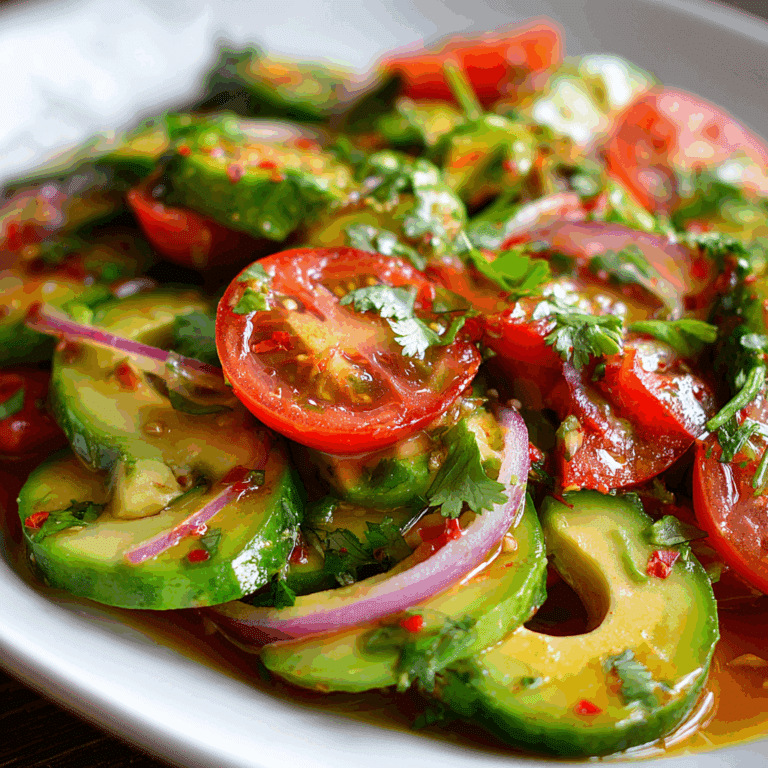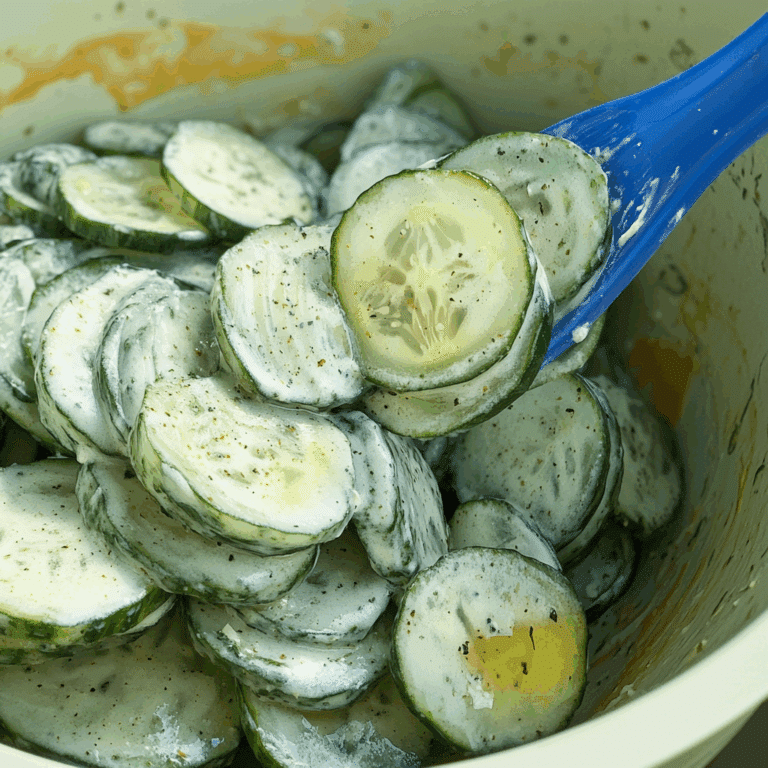How to Make Greek Salad with Feta and Olives

Discover a fresh and easy Greek Salad with Feta and Olives recipe perfect for a healthy, flavorful Mediterranean meal in minutes. This vibrant salad combines crisp vegetables, tangy olives, creamy feta cheese, and a zesty dressing to create a delicious dish that is both satisfying and nourishing. Whether you’re planning a light lunch, a side dish for dinner, or a colorful addition to your picnic, this Greek Salad with Feta and Olives is a go-to recipe that celebrates bold flavors and wholesome ingredients.
Why You’ll Love This Recipe
- Fresh and vibrant flavors: Every bite bursts with the bright taste of ripe vegetables and salty olives, balanced perfectly with creamy feta.
- Quick and easy to prepare: With just a handful of ingredients, you can whip up this salad in under 15 minutes.
- Healthy and nutrient-rich: Loaded with fresh vegetables and healthy fats, it’s a guilt-free meal or side dish.
- Perfect for any occasion: Whether for a family dinner, picnic, or potluck, this salad adapts effortlessly to your needs.
- Vegetarian and gluten-free: It caters well to those with dietary restrictions without sacrificing flavor.
Ingredients You’ll Need
Simple, fresh, and essential ingredients make this Greek Salad with Feta and Olives shine. Each component adds its own special texture, taste, and color to the dish, making the salad truly irresistible.
- Ripe tomatoes: Use juicy, firm tomatoes for sweet, tangy bites that form the salad’s base.
- Crisp cucumbers: Fresh cucumber slices provide a refreshing crunch and cooling balance.
- Kalamata olives: These salty, slightly bitter olives add authentic Mediterranean flavor.
- Feta cheese: Crumbled feta offers creaminess and a tangy contrast that complements the vegetables.
- Red onion: Thinly sliced for a sharp bite and a splash of color.
- Extra virgin olive oil: A generous drizzle brings richness and helps marry the flavors.
- Fresh lemon juice: Adds brightness and a zesty acidity that livens up the salad.
- Dried oregano: A classic Greek herb that infuses an earthy, aromatic note.
- Salt and pepper: Essential to season and enhance the overall flavor.
Variations for Greek Salad with Feta and Olives
One of the best things about this Greek Salad with Feta and Olives recipe is how easy it is to make your own. Feel free to tweak it to suit your taste preferences, dietary needs, or what you have on hand.
- Add bell peppers: For extra crunch and a sweet, colorful touch.
- Include fresh herbs: Try fresh parsley or mint for a refreshing twist.
- Swap feta for vegan cheese: Perfect for a dairy-free version that still delivers bold flavor.
- Use red wine vinegar: Instead of lemon juice for a slightly different tang.
- Add toasted pine nuts: For an extra layer of texture and nuttiness.

How to Make Greek Salad with Feta and Olives
Step 1: Prepare the vegetables
Start by washing and drying your tomatoes and cucumbers. Cut the tomatoes into bite-sized wedges and slice the cucumbers into thin rounds or half-moons for the perfect salad texture. Thinly slice the red onion to add a sharp contrast.
Step 2: Assemble the salad base
In a large bowl, combine the chopped tomatoes, cucumbers, sliced onion, and Kalamata olives. Give everything a gentle toss to mix the ingredients evenly without bruising the vegetables.
Step 3: Add the feta cheese
crumble the feta cheese on top of the mixed vegetables. You want plenty of creamy cheese distributed throughout to balance the salty olives and fresh veggies.
Step 4: Make the dressing
Whisk together extra virgin olive oil, fresh lemon juice, dried oregano, salt, and pepper in a small bowl until well combined. This simple yet vibrant dressing will coat the salad beautifully.
Step 5: Dress the salad and toss
Pour the dressing over the salad and gently toss everything together, ensuring the flavors mingle but the ingredients remain fresh and crisp.
Step 6: Serve immediately
Enjoy the salad right away to savor its bright flavors and textures. If needed, chill briefly before serving, but avoid letting it sit too long to maintain freshness.
Pro Tips for Making Greek Salad with Feta and Olives
- Use fresh, seasonal vegetables: The quality of produce makes a huge difference in flavor and texture.
- Choose authentic Kalamata olives: They bring the true Mediterranean taste to your salad.
- Drain extra liquid from tomatoes: To prevent the salad from becoming watery, gently drain the tomato juices before combining.
- Opt for block feta: Crumble it yourself for a fresher texture and richer flavor.
- Add dressing sparingly at first: You can always add more, but overdressing can weigh down the crisp veggies.
How to Serve Greek Salad with Feta and Olives
Garnishes
Finish your salad with a sprinkle of freshly chopped parsley or oregano for an herbal lift and a light drizzle of high-quality olive oil to enhance richness.
Side Dishes
This Greek Salad with Feta and Olives pairs wonderfully with grilled meats, pita bread, or a hearty bean dish, making it a versatile side or main on its own.
Creative Ways to Present
Serve the salad in a large rustic bowl for family-style dining or portion it into individual cups or lettuce cups for a charming appetizer presentation.
Make Ahead and Storage
Storing Leftovers
Keep leftover Greek Salad with Feta and Olives in an airtight container in the refrigerator. For best freshness, store the dressing separately and toss before serving again.
Freezing
This salad is best enjoyed fresh. Freezing is not recommended as the textures of fresh vegetables and cheese will degrade.
Reheating
Greek Salad with Feta and Olives is served cold, so reheating is unnecessary. Instead, just toss the salad again and add a bit more olive oil or lemon juice if needed before serving.
FAQs
Can I use a different cheese instead of feta?
Yes! While feta is traditional, you can substitute with goat cheese or ricotta salata for a similar tangy and creamy texture.
How long does Greek Salad with Feta and Olives keep in the fridge?
To enjoy the freshest taste and texture, consume within 1-2 days. Vegetable water release and cheese softness can change after this time.
Is this salad suitable for vegan diets?
You can easily make a vegan version by replacing feta with a plant-based cheese alternative and ensuring the dressing contains no honey or animal products.
What can I add to make the salad more filling?
Additions like cooked quinoa, chickpeas, or grilled chicken can turn this salad into a more substantial meal.
Can I prepare the salad ahead of time for a party?
Prepare all ingredients separately and mix just before serving to maintain freshness and crispness.
Final Thoughts
Greek Salad with Feta and Olives is a timeless dish that brings a refreshing burst of Mediterranean sunshine to your table. Its simplicity, vibrant flavors, and wholesome ingredients make it one of those recipes that you’ll want to come back to again and again. Give this recipe a try and enjoy a fantastic taste of Greece in the comfort of your own kitchen!
Related Posts
- How to Make Sichuan Cucumber Salad Fast
- 5 Easy Ways to Make Broccoli Salad
- Easy Indonesian Gado Gado with Peanut Sauce Recipe
Greek Salad with Feta and Olives
A fresh, easy, and vibrant Greek Salad with Feta and Olives combining ripe tomatoes, crisp cucumbers, Kalamata olives, creamy feta cheese, and a zesty lemon-oregano dressing. Perfect as a healthy vegetarian and gluten-free meal or side dish, ready in under 15 minutes and packed with Mediterranean flavors.
- Prep Time: 10 minutes
- Cook Time: 0 minutes
- Total Time: 10 minutes
- Yield: 4 servings 1x
- Category: Appetizers
- Method: No cooking required
- Cuisine: Greek
- Diet: Vegetarian, Gluten Free
Ingredients
Vegetables
- 2 cups ripe tomatoes, cut into bite-sized wedges
- 1 cup crisp cucumbers, sliced into thin rounds or half-moons
- 1/2 cup red onion, thinly sliced
Other Salad Components
- 1/2 cup Kalamata olives, pitted
- 1 cup feta cheese, crumbled (block feta recommended)
Dressing
- 3 tablespoons extra virgin olive oil
- 2 tablespoons fresh lemon juice
- 1 teaspoon dried oregano
- Salt, to taste
- Black pepper, to taste
Instructions
- Prepare the vegetables: Wash and dry the tomatoes and cucumbers thoroughly. Cut the tomatoes into bite-sized wedges and slice the cucumbers into thin rounds or half-moons. Thinly slice the red onion for a sharp bite and color contrast.
- Assemble the salad base: In a large bowl, combine the chopped tomatoes, cucumber slices, sliced red onion, and Kalamata olives. Gently toss to mix without bruising the vegetables.
- Add the feta cheese: Crumble the feta cheese evenly over the mixed vegetables to add creamy, tangy flavor throughout the salad.
- Make the dressing: In a small bowl, whisk together the extra virgin olive oil, fresh lemon juice, dried oregano, salt, and black pepper until well combined.
- Dress the salad and toss: Pour the dressing over the salad and gently toss everything together, ensuring the ingredients are evenly coated while keeping their crisp texture.
- Serve immediately: Enjoy the salad fresh to savor its vibrant flavors and textures. You may chill briefly before serving but avoid letting it sit too long to maintain freshness.
Notes
- Use fresh, seasonal vegetables for the best flavor and texture.
- Choose authentic Kalamata olives to bring genuine Mediterranean taste.
- Drain excess liquid from tomatoes to prevent a watery salad.
- Opt for block feta cheese and crumble it yourself for fresher texture.
- Add dressing sparingly at first to avoid soggy vegetables; you can always add more.
Nutrition
- Serving Size: 1 cup
- Calories: 150 kcal
- Sugar: 4 g
- Sodium: 400 mg
- Fat: 13 g
- Saturated Fat: 5 g
- Unsaturated Fat: 7 g
- Trans Fat: 0 g
- Carbohydrates: 6 g
- Fiber: 2 g
- Protein: 4 g
- Cholesterol: 15 mg
Keywords: Greek salad, feta cheese, olives, Mediterranean, vegetarian, gluten-free, quick salad, healthy recipe







